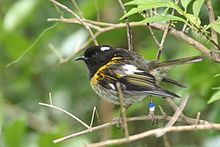Stitchbird
| Stitchbird | |
|---|---|
 |
|
| Male | |
 |
|
| Female in typical 'tail cocked' stance. | |
| Scientific classification | |
| Kingdom: | Animalia |
| Phylum: | Chordata |
| Class: | Aves |
| Order: | Passeriformes |
| Suborder: | Passeri |
| Family: |
Notiomystidae Driskell et al., 2007 |
| Genus: |
Notiomystis Richmond, 1908 |
| Species: | N. cincta |
| Binomial name | |
|
Notiomystis cincta (Du Bus, 1839) |
|
The stitchbird or hihi (Notiomystis cincta) is a rare honeyeater-like bird endemic to the North Island and adjacent offshore islands of New Zealand. It became extirpated everywhere except Little Barrier Island but has been reintroduced to three other island sanctuaries and two locations on the North Island mainland. Its evolutionary relationships have long puzzled ornithologists, but it is now classed as the only member of its own family, the Notiomystidae.
The stitchbird was originally described as a member of the primarily Australian and New Guinean honeyeater family Meliphagidae. It has remained classified as such until recently. Genetic analysis shows that it is not closely related to the honeyeaters and their allies and that its closest living relatives are within the endemic New Zealand Callaeidae. In 2007 a new passerine family was erected to contain the stitchbird, the Notiomystidae.
The stitchbird is a small honeyeater-like bird. Males have a dark velvety cap and short white ear-tufts, which can be raised somewhat away from the head. A yellow band across the chest separates the black head from the rest of the body, which is grey. Females and juveniles are duller than males, lacking the black head and yellow chest band. The bill is rather thin and somewhat curved, and the tongue is long with a brush at the end for collecting nectar. Thin whiskers project out and slightly forward from the base of the bill.
Stitchbirds are very active and call frequently. Their most common call, a tzit tzit sound, is believed to be the source of their common name, as Buller noted that it "has a fanciful resemblance to the word stitch". They also have a high-pitched whistle and an alarm call which is a nasal pek like a bellbird. Males give a piercing three-note whistle (often heard in spring) and a variety of other calls not given by the female.
...
Wikipedia

